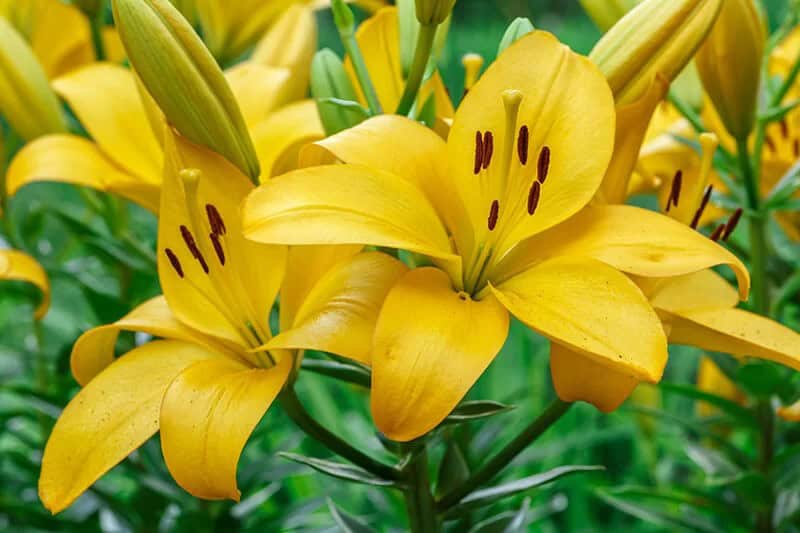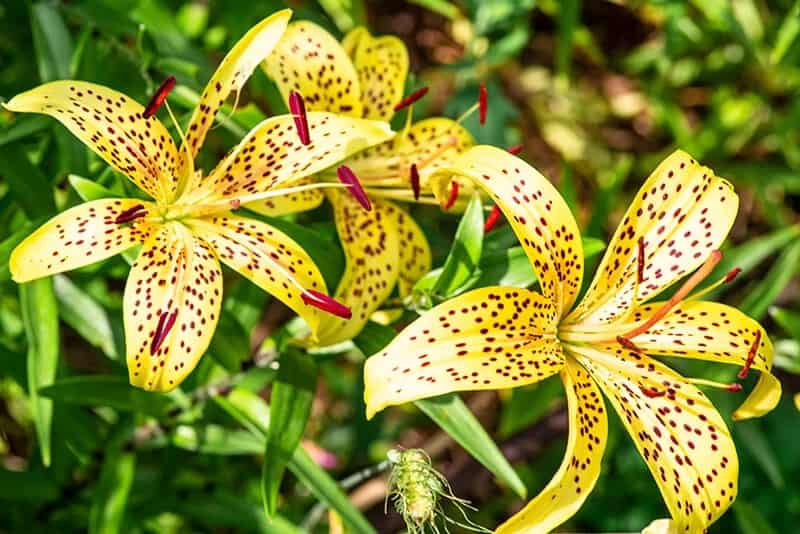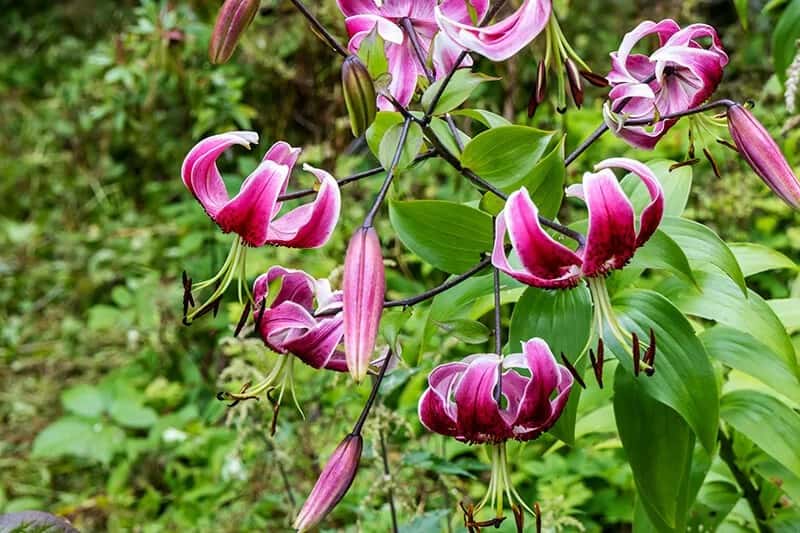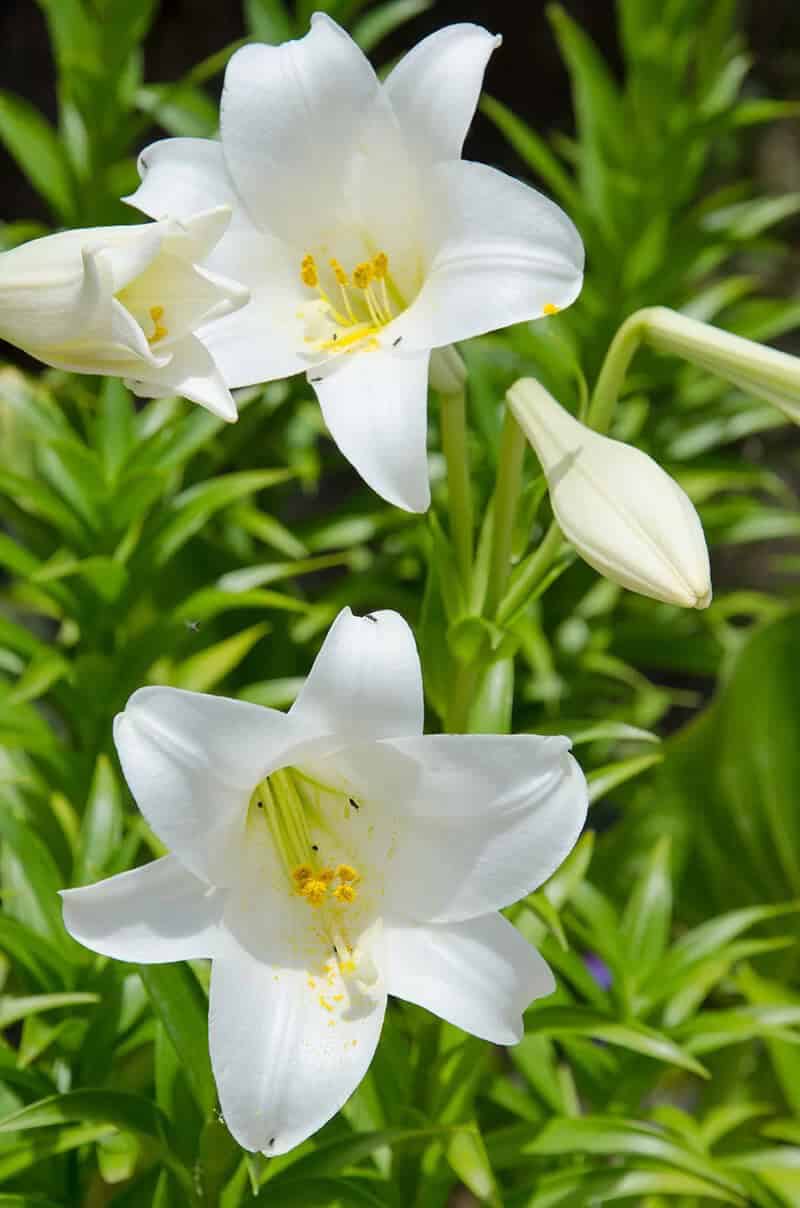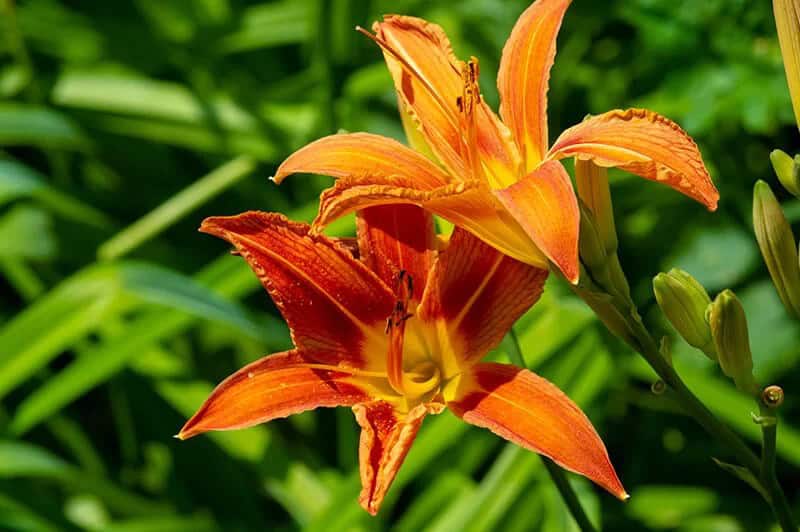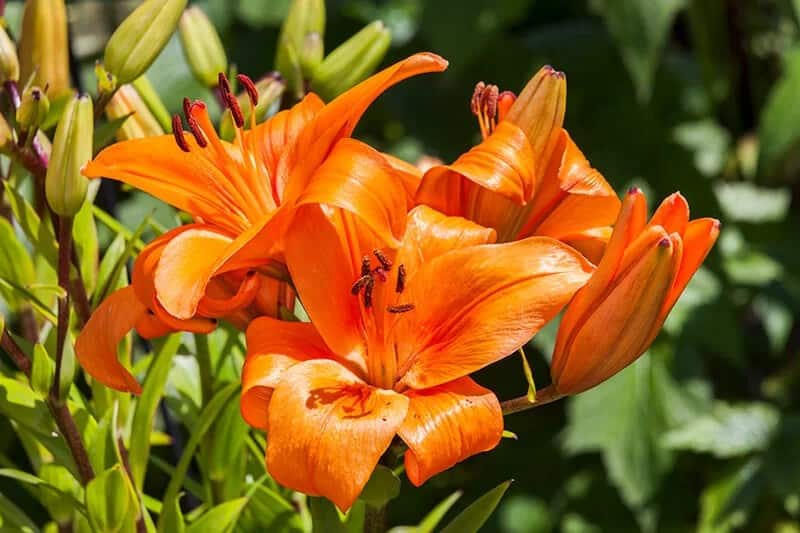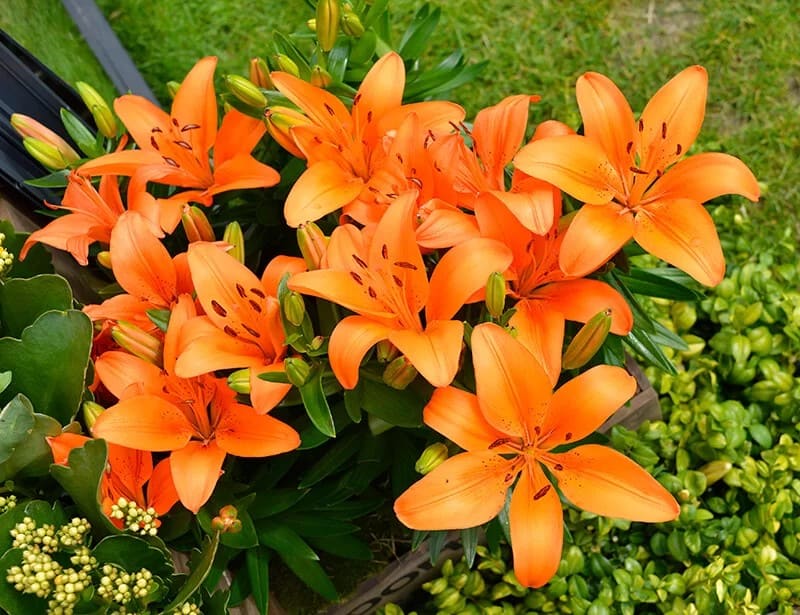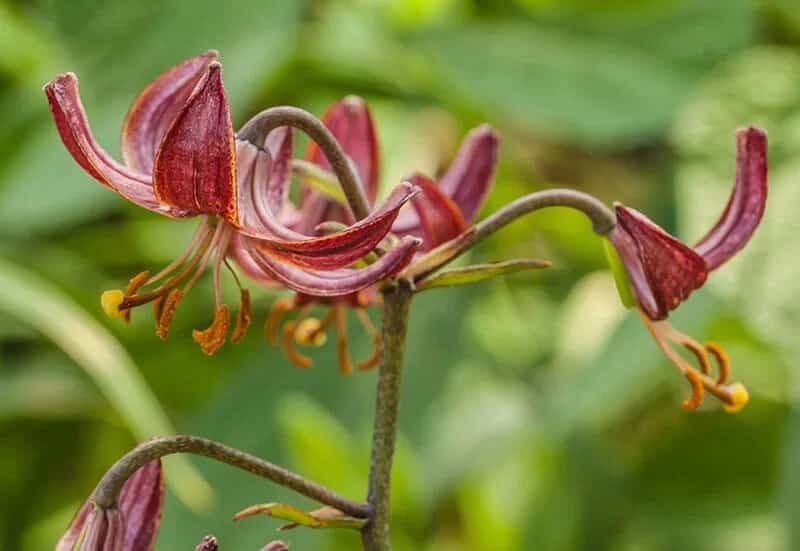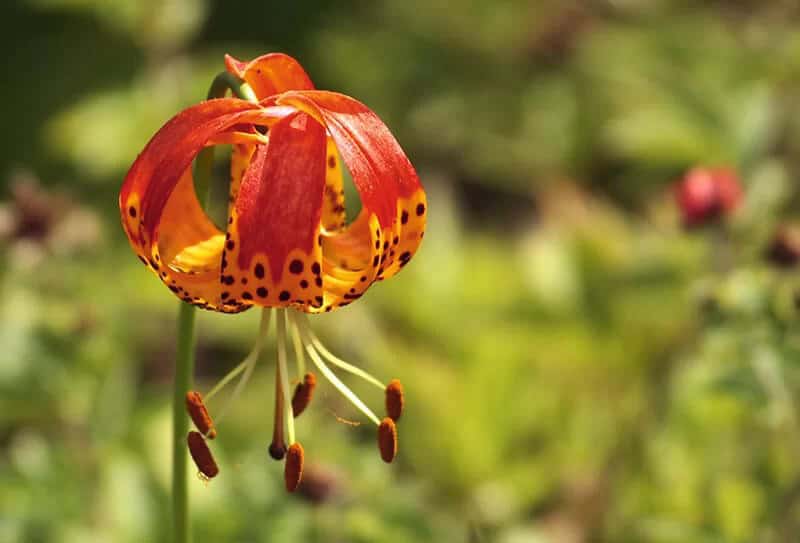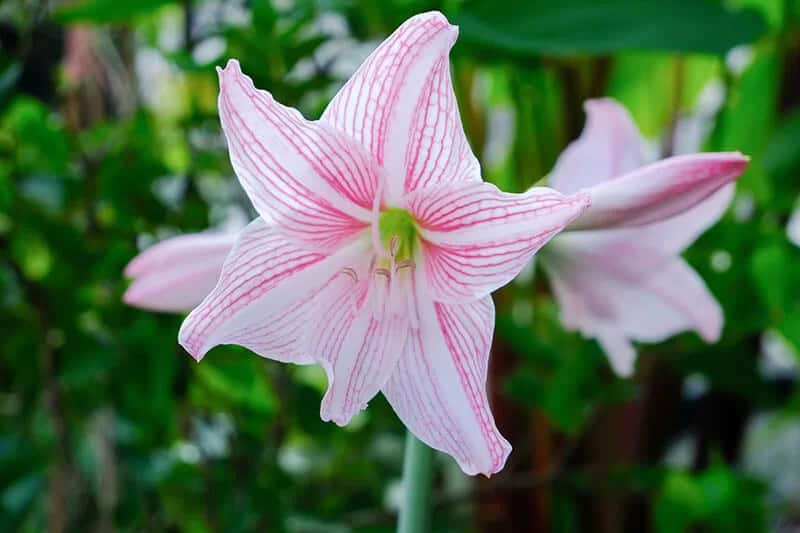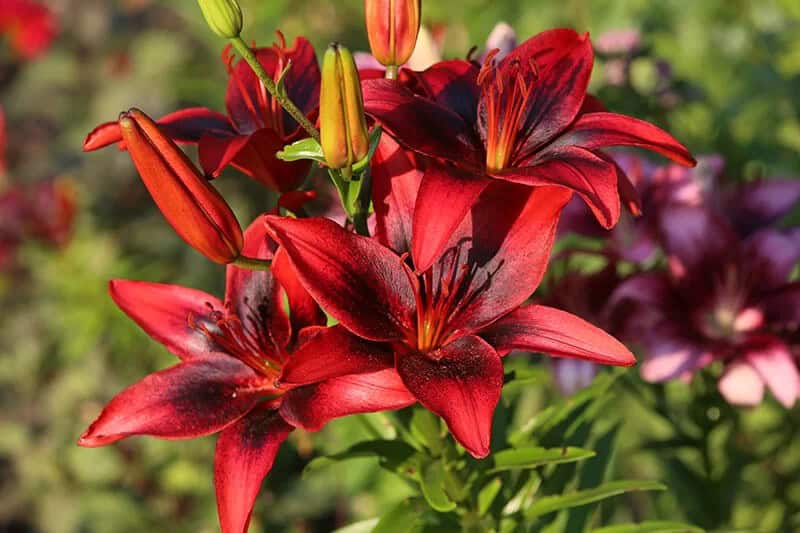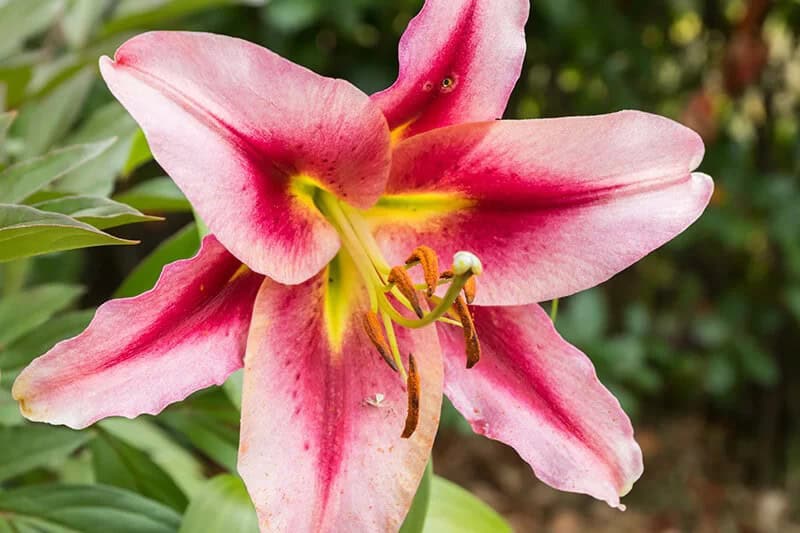One of the most endearing qualities of lily flowers is the intoxicating fragrance they emit, a trait that’s often overlooked in favor of their more showy characteristics. But beyond their signature scent, there are numerous reasons to appreciate these beloved blooms.
Their remarkable adaptability and vibrancy make them a gardener’s dream come true. With a kaleidoscope of colors, shapes, and sizes, each lily flower is a unique work of art that brings joy to any garden or arrangement.
27 Types of Lily Flowers to Grow in Your Garden
Lilies are renowned for their striking, detailed blooms that not only add vibrancy to flower beds but also fill the air with a pleasing aroma. With a history spanning thousands of years, these adaptable plants have thrived naturally across North America, Europe, and Asia. As human civilization evolved, gardeners fell in love with lilies’ beauty and began cultivating them.
If you’re looking to bring some of this elegance into your own garden, here’s an overview of the diverse types of lily flowers you can grow.
Lilium Canadense (Canada Lily)
Lilium canadense, a rare breed of cool lilies, boasts a unique characteristic – its shrubby bulb gives rise to tiny, yet elegant flowers. Unlike its larger trumpet-shaped relatives, this variety features delicate yellow blooms with sharply pointed petals that stretch outwards and upwards, adorned with faint orange-brown freckles towards the center. Notably, the stems grow downwards from the base of the bulb, rather than extending from the top, creating a fascinating branching pattern.
As the sprouts develop, new bulbs emerge at their tips, eventually transitioning to the ground. With its medium water needs, well-drained soil, and full sun requirements, this plant thrives in zones 3 to 9, typically blooming from June to July.
Lilium Pardilinum (Leopard Lily)
The Leopard Lily is a fascinating North American genus, native to the Pacific shores. Its pendent flowers dangle elegantly from woody stems, resembling tiny lamps. The striking orange-red petals gradually fade to golden yellow in the center, showcasing a unique and eye-catching color combination. This lovely lily earns its popular name due to the scattered darker patches on the yellow areas.
As a woodland genus, Lilium Pardilinum is one of the few lilies that thrive in partial shade, making it an ideal choice for gardens with limited sunlight. With proper care, these flowers can grow up to six feet tall and form natural bunches over time. They require well-drained soils, medium watering, and can tolerate some drying out. These hardy blooms also enjoy partial sun and can be found growing in zones 5 through 9.
Their summer-to-early-fall blooming season adds to their appeal, making them a popular choice among gardeners.
Lilium Martagon (Martagon Lily)
The Lilium Martagon is a unique and sought-after plant among gardeners for its ability to naturalize over time, creating a stunning display with minimal maintenance. One of its most attractive features is its adaptability to varying light conditions, thriving in both full sun and partial shade. The original Martagon Lily boasts a beautiful soft purple to pink hue, while an albino white variety is also available.
A striking characteristic of this lily species is the way its pendent blooms twist back upon themselves, touching the base of the flowers. The delicate freckles on each bloom add to their charm. While the foliage may be sparse, the abundance of these captivating flowers makes up for it, ensuring a summer-long display of beauty and pride.
Lilium Bulbiferum (Fire Lily)
The Fire Lily, also known as the lily flower plant, has a rich symbolism attached to it – purity and modesty. This beautiful flower requires medium watering levels and thrives in moist but well-drained soil. Its growing zones span from 3 to 9, making it a versatile option for gardeners. As for light, Fire Lilies prefer full to partial sun exposure. The blooming season typically falls under early summer, adding to the plant’s charm.
Historically, the Fire Lily was grown extensively in southern Europe’s highlands and has since been used to create stunning Asiatic mixes. One of its notable features is the presence of deeper, chocolate-colored dots on the petals. Interestingly, this plant is relatively easy to spread due to the formation of bulbils that grow between the leaf and stem in the axil. As they readily peel away, simply pot them up for successful propagation.
Lilium Longiflorum (Easter Lily)
The Festive Lily is an exquisite flower with whole white funnel-shaped blossoms that inspired the development of stunning crosses like White American. This lily thrives in warm environments, where it can be grown outdoors. However, those living in colder climates must cultivate Easter Lilies under glass or sow them in pots that can be moved indoors during the winter season. Symbolically, the Festive Lily represents innocence, rebirth, fresh starts, and faith.
It requires slightly moist soil with open, free-draining humus-rich loamy conditions. With a growing zone of 5 to 8 and full to partial sunlight, this lily blooms late in the summer. Its care is relatively straightforward, needing only a moderate level of water and an abundance of sunlight.
Henry’s Lily (Lilium Henryi)
Henry’s Lily is a stunning ornamental flower that embodies symbolism of love, courage, passion, and fulfillment. This tropical orange beauty thrives in medium water conditions, preferring moist but well-drained soil. With a growing range spanning zones 5 to 8, Henry’s Lily can flourish in partial or full sunlight. Its early to mid-summer blooming season brings an abundance of showy blossoms, each adorned with intricate red bumps that add a unique tactile experience.
The blooms’ Turk’s Cap formation, where they bend backward towards the stalks, creates a striking visual display. Henry’s Lily is particularly well-suited for casual or naturalized plantings, making it an excellent choice for those seeking a low-maintenance yet visually striking addition to their gardens.
Lilium Lancifolium (Tiger Lily)
The Tiger Lily, with its striking peach-orange petals adorned with black dots that curl backward towards the stem, is a symbol of fertility, purity, innocence, and beauty. Native to Asia but now widespread in the United States, this hardy lily species thrives in well-drained soil and full to partial sun. While it’s drought-tolerant, regular watering is appreciated. In terms of growing conditions, Tiger Lilies do best in USDA zones 3 to 9, with a mid-to-late summer blooming season.
One notable characteristic is their dark stems, almost black, which provide a striking contrast to the vibrant orange flowers. What’s more, Tiger Lilies are resistant to viral infections, making them a safe choice for gardeners looking to add some variety without worrying about disease transmission. However, this hardiness also means they can be problematic when planted near other lily species, so it’s essential to keep them at a distance to avoid any potential issues.
Lilium Candidum (Madonna Lily)
The Madonna Lily, with its elegant white blooms, boasts a rich history dating back before the Christian era. This revered species was cultivated for both aesthetic and nutritional purposes. One of its most striking features is the large, pure white petals that occasionally display subtle light green accents in the center. The anthers, meanwhile, shine with a bright yellow hue. Symbolically, the Madonna Lily represents purity of the soul and chastity.
In terms of its growing conditions, this lily species requires evenly moist but not soggy soil, neutral or alkaline pH levels, and full to partial sun. It thrives in zones 6 to 9 and blooms during early summer. With its timeless beauty and symbolic significance, it’s no wonder the Madonna Lily remains an iconic and beloved flower.
Lilium Auratum (Golden-Rayed Lily)
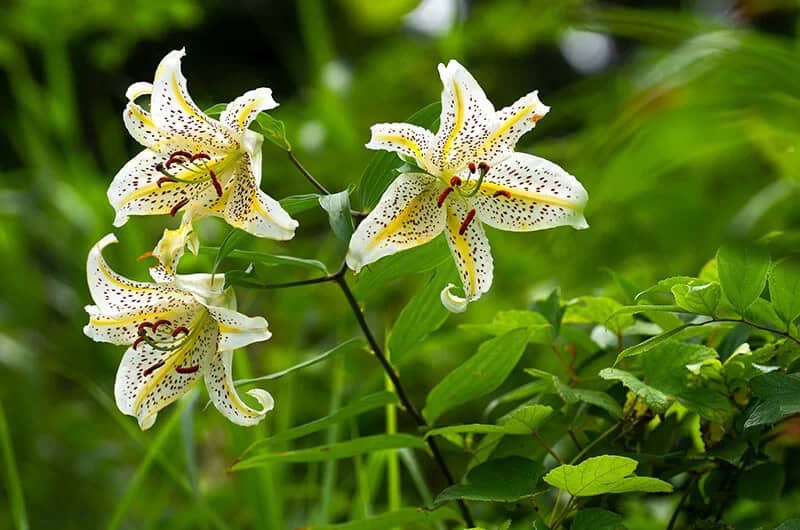
The wild Japanese lily flower plant is a breathtaking sight to behold, with its majestic blooms reaching 10-12 inches in diameter. The distinctive aroma of these flowers is truly unique, making them all the more captivating when placed near your home. As you draw closer to admire their beauty, you’ll notice the delicate white petals adorned with golden stripes forming a stunning star pattern.
Some varieties may feature tiny black dots scattered across each petal, while others display softer pink hues. With its modest growth habits and ability to thrive in well-drained soil, this plant is perfect for gardeners of all skill levels.
Lilium Speciosum (Oriental Lily)
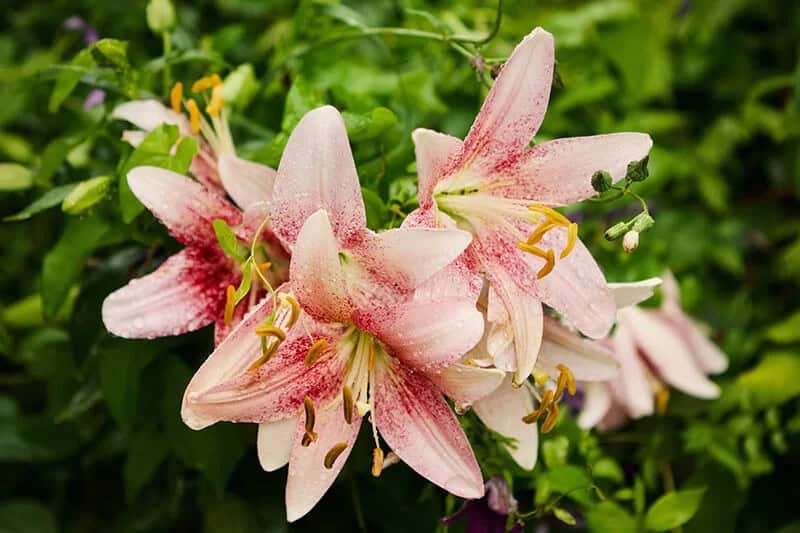
The Oriental Lily (photo credit: K Bro from pexels. com) is a symbol of rebirth and purity, making it a popular choice for those seeking to add meaning to their garden. This lily species requires medium watering, moist but well-drained soil, and thrives in USDA hardiness zones 5-7. As one of the few late-blooming lilies, Oriental Lilies are perfect for creating a show-stopping display that lasts throughout the season.
The pendent blooms, which can be white or tinged pink, appear in early autumn and are scattered along slender stalks adorned with raised ‘papillae’ lumps and darker pink dots. One key consideration when growing Oriental Lilies is their aversion to lime. This means that if you have saline soils, it’s best to plant them in pots filled with ericaceous manure.
Lilium ‘Enchantment’ (Enchantment Lily)
The Enchantment hybrid flower is a symbol of innocence and simplicity, as represented by the 🔮 symbol. This beautiful bloom requires medium 💧 water levels, well-drained 🪴 soil conditions, and can thrive in growing zones 4 to 8 🌍. The plant enjoys full ☀️ sunlight and blooms during the summer season 🌱. One of its unique features is its fiery orange flowers, which are subtly enhanced by darker dots, making it a show-stopping display.
The Enchantment hybrid has gained popularity for its ability to produce stunning cut blooms and its simplicity in cultivation. Moreover, it’s easy to propagate this flower for long-term enjoyment. A key characteristic is the formation of small bulbs, or bulbils, at the tips of non-flowering leaves along its stems.
Lilium ‘Connecticut King’
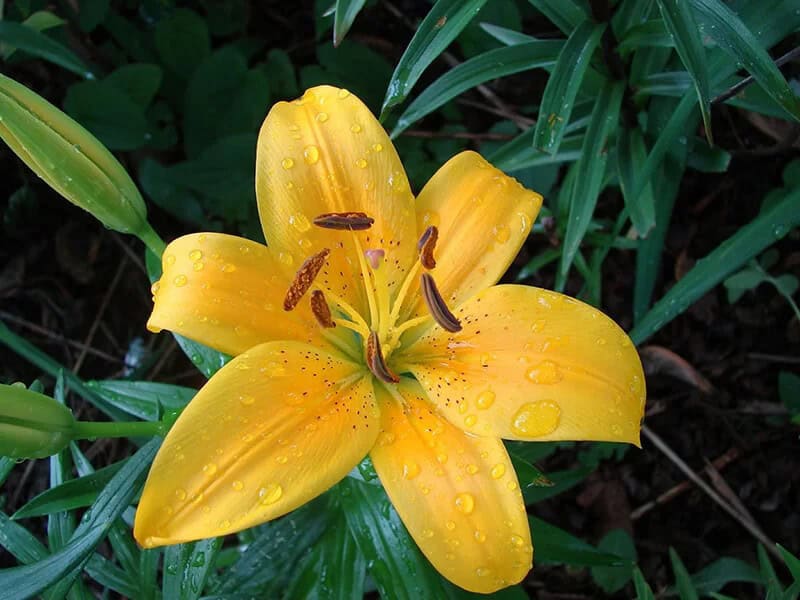
The Connecticut King flower boasts magnificent golden blooms free from any discoloration, while its leaves shine with a vibrant, electric green hue. As for its growing requirements, it thrives in soils that are moist but well-drained, and can tolerate partial to full sun. With an average water need and a blooming season that typically occurs in June, this flower is ideal for cultivation in USDA hardiness zones 4 to 8.
Furthermore, the Connecticut King’s symbolism is deeply rooted in concepts of purity and modesty, making it a popular choice among florists and garden enthusiasts.
Lilium Roma
The majestic and gorgeous Lily variety is a standout, boasting unique characteristics. Its pink blossoms transform into large, creamy flowers adorned with a subtle pattern of dots towards the center. Symbolically, Lilies are often associated with purity and heavenly connotations. In terms of growing conditions, this variety requires medium watering needs, fairly-draining moist soils, and can thrive in zones 3 to 9. It prefers full sun exposure and typically blooms during early summer.
Orange Pixie Lily
The Orange Pixie may be compact at just 8 inches tall, but its impact is anything but small. This vibrant variety produces stunning orange blooms that can last for several weeks, making it a true showstopper. Notably, it requires an alkaline and well-drained soil to thrive, with a growing zone ranging from 2 to 9. It also enjoys full to partial sunlight and moderate watering needs.
With its blooming season typically occurring between June and August, this charming species is sure to bring a pop of color and joy to any garden.
Denia Pixie Lily

The Pixabay photo provides a captivating visual representation of this rare and unique bloom. When it comes to symbolism, the flower is often associated with elitism, privilege, and devotion due to its scarcity. In terms of its horticultural needs, this plant requires medium watering, moist but not soggy soil, and can thrive in USDA growing zones 3 to 8. It also does well under full to partial sun exposure.
Mid-summer is the prime blooming season for these flowers, with the broad pink-hued petals featuring deeper brown flecks that add a distinct charm. For those seeking a more delicate appearance, Denia Pixie is an excellent option.
X Dalhansonii “Marhan”
From a symbolic standpoint, ‘Marhan’ embodies pureness and modesty. This hybrid lilium thrives in conditions characterized by medium water needs, moist yet well-drained soil, and can be grown in zones ranging from 3 to 7. Ideally, it requires partial sunlight to light shade.
In early summer, ‘Marhan’ blooms with soft, honey-colored flowers that exquisitely contrast against its dark green stalks, showcasing the influence of its parents, Lilium hansonii and Lilium martagon, while deviating from their characteristic curling bloom patterns.
Lilium Bellingham
Bellingham lilies are a robust cultivar that boasts towering spikes adorned with vibrant green leaves. As a symbol of pleasure, joy, and good vibes, these plants thrive in conditions characterized by medium water needs. Specifically, they prefer relatively moist, well-drained soil and full sun exposure. Growing zones 4 to 8 accommodate this variety’s growth. In mid-summer, Bellingham lilies will reward you with stunning, fiery-colored flowers in shades of red, orange, and yellow.
Lily ‘Cherrywood’
The Cherrywood flower is rich in symbolism, representing pride, success, appreciation, dignity, and achievement. It requires average water needs, with a preference for moist, well-drained soil. This flowering beauty thrives in zones 4 to 8, basking in the warmth of full sun. Its mid-summer blooming season is marked by its unique, dangling blossoms that transition from deep crimson at the tips to tangerine hues in the middle.
A sprinkling of red specks adds a touch of elegance to this stunning display. Like its parent plant, Lilium pardalinum, Cherrywood features clusters of leaves spaced along upright stems.
Lilium Longiflorum ‘White American’
The Easter Lily, White American variant, is a resilient plant that thrives when conditions are just right. Its sturdy stems are adorned with dark green, lance-shaped leaves, which provide a striking backdrop for the trumpet-shaped white summer flowers. These blooms feature subtle green-tinged tips and rust-orange anthers, adding to their visual appeal.
Interestingly, this variety requires a specific set of environmental factors to flourish, including average water needs, moist but well-drained soil, and a growing zone that falls within the range of 4 to 8. In terms of light, it prefers full sun to partial shade, with the ideal blooming season being summer.
Lilium ‘African Queen’ (Trumpet Lily)
The African Queen orchid boasts a striking symbol of friendship and humor through its vibrant orange blossoms with subtle purple-pink highlights. Requiring average water levels and thriving in well-drained moist soils, this epiphyte is adaptable to various climates. Its robust growth can reach up to six feet tall, with blooms radiating outward and downward. With full sun exposure, the African Queen group will flourish in most zones, making it a fantastic addition to any yard.
Its blooming season typically spans from July to August, injecting a tropical flair into your outdoor space.
Lilium ‘Golden Splendor’
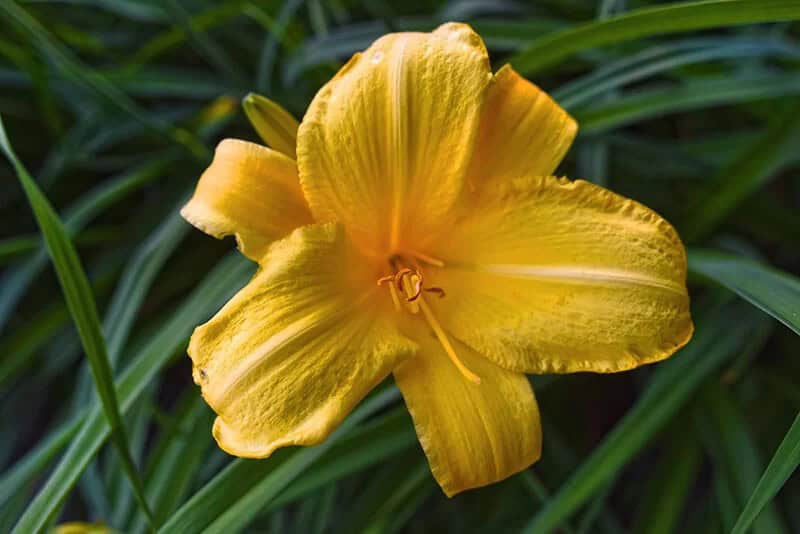
Golden Splendor lilies, a majestic sight to behold! Their stunning golden blooms are truly showstoppers, boasting soft purple buds that add an extra layer of visual appeal. With stems reaching up to four feet tall, these robust plants command attention. What’s more, their fragrance is reminiscent of trumpet varieties – a sensory delight. As if their beauty wasn’t enough, Golden Splendor lilies are also remarkably resilient, thriving in a range of conditions with the exception of extreme cold.
They require good soil moisture and full sun to flourish, making them an excellent choice for gardeners seeking a low-maintenance yet high-reward addition to their landscape.
Lilium Pink Perfection Group
The Pink Perfection trumpet lily is a stunning addition to any garden, with its large, dark pink or purple blooms reaching up to 10 inches in diameter. But what really sets it apart is its intoxicating aroma, a hallmark of the winner lily family. With medium water needs, this lily thrives in moist but well-drained soils that are slightly acidic. It’s a great choice for zones 4-9 and can be grown in full sun or partial shade.
The blooms appear mid to late summer and will last for several weeks, making it an excellent addition to any flower bed or container garden. Plus, the flowers make great cut flowers, so you can enjoy them indoors as well. Overall, Pink Perfection is a must-have for anyone who loves bold, dark pink or purple flowers.
‘Bright Star’ Lily
The ‘Bright Star’ lily is a stunning sight to behold, with its massive white blooms featuring vibrant orange centers that give it a radiant, star-like appearance. This unique variety is the result of crossing the trumpet lily (L. centifolium) with L. henryi, which has resulted in a shallower form than other trumpet varieties. Sometimes referred to as ‘sunburst’ lilies, this type of hybrid is characterized by its flatter shape and bright, shining blooms.
A closer look at the flower’s core will reveal an intricate light green star created by the nectary furrows, adding an extra layer of beauty to this already impressive bloom. The ‘Bright Star’ lily has been a favorite among gardeners since its introduction in the 1930s, when it was bred by Jan de Graaf at Oregon Bulb Farms.
Lilium ‘Forza Red’
The LA Hybrid ‘Forza Red’ lives up to its name, symbolizing pride, achievement, and elegance through its stunning dark crimson blooms. These showstoppers boast the same radiant maroon color throughout their entirety, thanks to their L. longiflorum heritage. The large flowers are a favorite among florists, who appreciate the plant’s ability to thrive in conditions that include well-drained soil rich in humus, average water needs, and full sun.
In fact, ‘Forza Red’ does best in zones 5 to 9, where it can bloom beautifully in June.
Lilium ‘Scheherazade’
The majestic ‘Scheherazade’ blooms boast a regal charm, with flower spikes reaching up to 7 feet tall and adorned with gracefully nodding blossoms. The deep red petals feature a delicate cream edging, while the large black anthers protrude several inches from the main bloom, adding a striking visual element. Under full sun to partial shade, this beauty can thrive in medium water conditions and moist, well-drained alkaline soils.
Its growing zones span 5 to 9, with blooming season typically occurring mid to late summer. In fact, it’s not uncommon for a single stem to produce up to 40 flowers.
Lilium Black Beauty
The symbolism behind Black Beauty’s appearance is rooted in refinement, beauty, and secrecy. This striking flower thrives in environments that mimic these qualities, with average water needs and a specific soil profile – fertile, acidic, and well-drained. Its growing zones are 5-8, making it an ideal choice for gardeners in those regions.
When it comes to light, Black Beauty demands full sun to showcase its vibrant colors.
The blooming season is late summer and early autumn, a time of year when the flower’s rich red exterior petals and lime green star-shaped centers are truly on display.
One of the most impressive aspects of Black Beauty is its ability to produce an abundance of blooms – at least 50 per head, with occasional bursts of 100 or 150 blossoms. This is due in part to the massive bulbs that support the weight of the sprouts and flowers.
In a unique twist, Black Beauty’s genetic makeup allows it to thrive in saline soils, making it an excellent choice for gardeners looking to add some drama to their coastal landscapes. Additionally, its ability to tolerate lime-rich soil means it won’t be fazed by these conditions, thanks to the influence of L. henryi.
Oriental Lily Acapulco
The Acapulco Lily boasts a stunning appearance that’s sure to delight all fans of the color pink. Its vibrant cerise flowers feature deeper pink dots in the center, surrounded by softly curled outer petals that create a delicate, relaxing profile. This variety also emits a lovely fragrance, making it an excellent choice for presentations or special occasions. In terms of growing conditions, the Acapulco Lily requires average water needs, well-draining loamy soil, and can thrive in zones 3 to 8.
It prefers full sun to partial shade and blooms mid to late summer, providing a pop of color during this time of year.
27 Perfect Types of Lily Flowers for Your Outdoor Area
Lilies are a quintessential summertime bloom that adds an air of elegance to any garden landscape. Their striking appearance and versatility also make them a unique gift option. With numerous varieties to choose from, it’s not uncommon for garden enthusiasts and gift-givers alike to find themselves overwhelmed by the sheer diversity of lily types.
Whether you’re searching for a specific variety or simply looking to add some visual interest to your outdoor space, discovering a beautiful lily online can be an excellent way to bring your vision to life.
